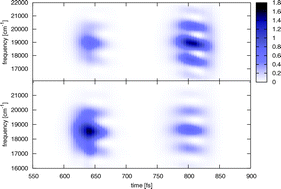Shaping femtosecond coherent anti-Stokes Raman spectra using optimal control theory
Abstract
Optimal control theory is used to tailor laser pulses which enhance a femtosecond time-resolved coherent anti-Stokes Raman scattering (fs-CARS)

* Corresponding authors
a
School of Engineering and Science, Jacobs University Bremen, Campus Ring 1, Bremen, Germany
E-mail:
u.kleinekathoefer@jacobs-university.de
b Institut für Physik, Technische Universität Chemnitz, Chemnitz, Germany
Optimal control theory is used to tailor laser pulses which enhance a femtosecond time-resolved coherent anti-Stokes Raman scattering (fs-CARS)

 Please wait while we load your content...
Something went wrong. Try again?
Please wait while we load your content...
Something went wrong. Try again?
S. Pezeshki, M. Schreiber and U. Kleinekathöfer, Phys. Chem. Chem. Phys., 2008, 10, 2058 DOI: 10.1039/B714268D
To request permission to reproduce material from this article, please go to the Copyright Clearance Center request page.
If you are an author contributing to an RSC publication, you do not need to request permission provided correct acknowledgement is given.
If you are the author of this article, you do not need to request permission to reproduce figures and diagrams provided correct acknowledgement is given. If you want to reproduce the whole article in a third-party publication (excluding your thesis/dissertation for which permission is not required) please go to the Copyright Clearance Center request page.
Read more about how to correctly acknowledge RSC content.
 Fetching data from CrossRef.
Fetching data from CrossRef.
This may take some time to load.
Loading related content
